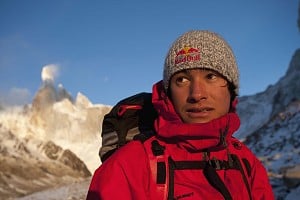
David Lama (check his Website and Facebook page) is a twenty two year old Austrian climber. The young athlete has competed at the highest level, and has more recently turned his attention to the higher mountains. Earlier this year Lama free climbed the infamous Compressor Route on Patagonia's Cerro Torre, but not after some controversy (full UKC Article here).
Almost a year on and Lama is showing no signs of slowing down. A recent recce trip to Trango Tower in Pakistan saw the driven climber testing his reserves at altitude, and he is keen to return to Pakistan next year to take high standard free climbing in to the Himalayan arena.
Opinionated, strong-willed, determined and successful, we spoke at length with the young Austrian, who is currently in the running for the prestigious National Geographic Adventurer of the year.
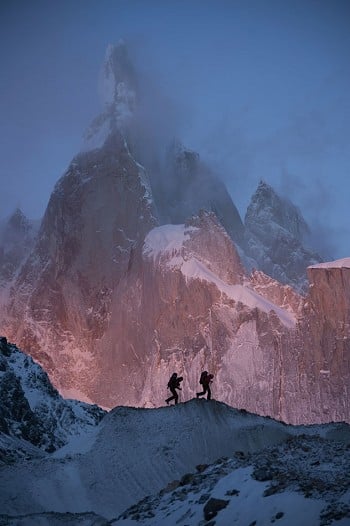
INTERVIEW: David Lama
Where did you start climbing? Was it with your parents? And in what style?
My parents were no climbers at all, before I started with it, but they were outdoor and mountain enthusiasts. I started climbing when I was around 5 years old. Peter Habeler, the partner of Reinhold Messner on the first ascent of Mt. Everest without supplementary oxygen, was a friend of my parents and invited me to one of his outdoor camps for kids in the Zillertal back in 1995. We were doing some glacier hikes, went on some easy mountains and one day also went climbing on some rock slabs, close to the hut we were staying at. Peter noticed my feeling for the rock and the fun I was having and therefore encouraged my parents to let me climb with Reini Scherer, who at that time led a climbing group for kids.
Your father is from Nepal. What influence does this Sherpa heritage play on your climbing life?
This is a question I get asked a lot. Both of my parents (my mom is from Austria) are mountain enthusiasts and therefore my early childhood days were full of hiking and adventure, both in Nepal and in Austria, and this influenced my personality for sure. People have said that I'll be able to deal with high altitudes better due to my father being a Sherpa but I'm not sure about that. Personally I have the impression that I benefit much more from the calm and even-tempered approach to life that certainly comes from my father's side.
You started climbing at a young age and then soon got involved with competition climbing. Do you feel that this gave you a good introduction to the sport?
I started on rock and then got into competitions, not the other way around. I think that mainly starting at a young age gives you an advantage, just as in every other sport. For me, the combination of rock climbing and the eagerness to compete were for sure a good motivation to train hard and to get better.
Has climbing changed for you since those early days? Are you looking for something different in climbing now? Or is it the same?
It hasn't changed in the respect that climbing is and will always be the center of my life. But my perception of life has evolved together with my view on climbing and vice versa.
And after a successful competition career you stopped competition climbing after the 2010 season. Do you think you will return to this at some stage in the future?
It wasn't with a heavy heart that I left the competitions. Already back in 2008 I felt that my perceptions and visions for my climbing future didn't fit within the confines of a gym or a set of rules. When leaving the comps I actually had the intention of coming back in some years, but to be honest for the moment I don't see a single reason why I should, especially with the format that still exists. I still climb in the gym to train, but I'm not sure if I'll ever fit into the world of rules and regulations again that the World Cup currently represents for me.
It seems that you have some strong ideas about the World Cup and the format of the competitions. How do you think it could be improved? What do you think of the overall competition organisation - and any thoughts on climbing and the fact that it might possibly be heading to the olympic games?
I couldn't care less about the Olympics; I don't give much about this platform. Generally speaking, I believe that competition climbing will further evolve and more and more become a sport of its own, much further away from the original climbing than now. This doesn't necessarily have to be a bad thing, but it's simply not my thing. For me the World Cup currently doesn't breathe "climbing DNA" and that's what I'm missing.
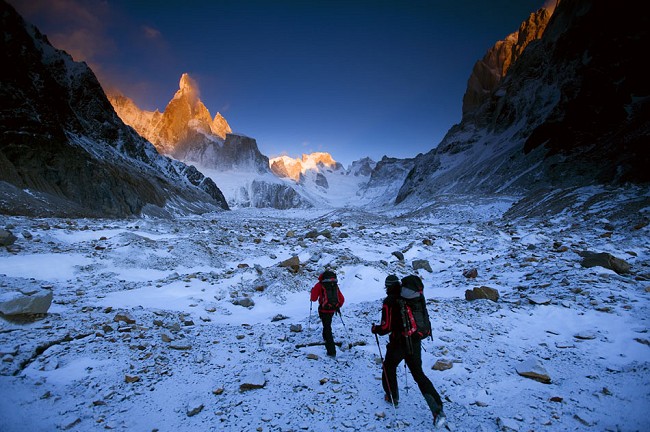
Competitions have got a lot more specific over the past couple of years and the level necessary to win increased quite a bit. When I entered the comps I used to be able to go rock climbing a lot while I was still able to win World Cups. It depends what expectations you have on yourself, but with the increasing density of strong competition athletes that focus mainly on the indoor climbing, there is no chance to do well without specific training on plastic.
Being an alpinist and especially going on expeditions several times a year is totally counterproductive to a competitors cycle, so there is no way to combine these two disciplines without making major compromises, especially if you have the ambition to win as I always did.
And back to what you have been doing out in the world of mountains and rock.So far in your climbing life what do you regard as your greatest climbing achievement?
That's a difficult question; there are quite a few first ascents that I'm proud of. But if I had to choose one it would probably be the first free ascent of Cerro Torre's SE-ridge, as I failed multiple times before I finally succeeded earlier this year. Furthermore I was confronted with a lot of critique due to mistakes that were made in course of producing a film on my first attempt, which made me reevaluate a lot of different things. I went through hell and back before I was able to realize my dream. For no other project so far I had to grow as much, not just as a climber.
Going through hell and back, and also reevaluating a lot of different things. It seems that Cerro Torre was indeed a tough challenge, both the climbing of course, and the reaction from climbers following your attempts. You have grown as a person - what have you learnt? And could you pass on any advice to other young climbers after this experience? If you could go back in time, would you do it again, or differently?
If I went there now I would probably start off the project in the way I brought it to an end, but I certainly don't want to miss the experiences made. What I learned was definitely that mistakes, no matter how big, are just a status quo of a situation and offer a range of opportunities to grow on. My advice to young climbers would probably be: Go out there and make your own mistakes!
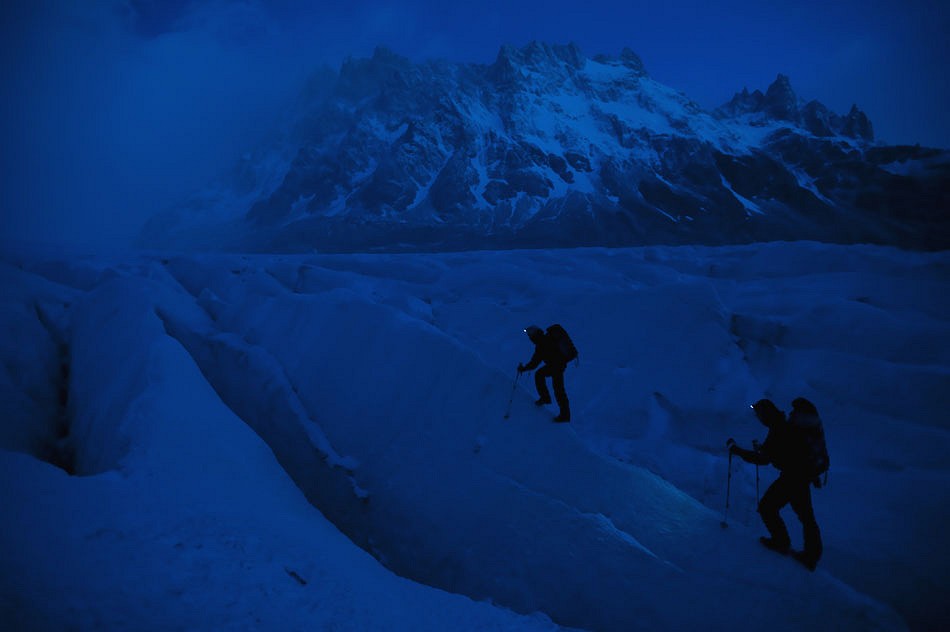
In 2011 there was some controversy before your trip since you had stated that you planned to take a drill, and use the old bolts for protection on your free attempt. In the end you didn't use a drill and the upper bolt ladder had been removed just before you got there. What you achieved was amazing, but I am interested as to why your original plans had been less ambitious and clean than what it turned out you were capable of?
My plan had always been ambitious and it actually didn't change a lot over the years. But as there was no real achievement in the first two years of attempting, all that was visible for the climbing world was the controversy concerning the filming bolts. I had always planned on clipping Maestri's bolts for protection. The route was there back then, and why pretend it wasn't? Regarding the alternations for a free ascent I had always hoped to be able to protect the climb exclusively with removable gear, but I had always suspected that there are some long, blank sections which are free climbable, but not protectable with removable gear; for those I had considered hand-drilling bolts. The fact that the Maestri bolts of the headwall were chopped for sure didn't make the whole endeavor easier, but actually the psychologically most demanding part first starts when you leave the compressor route. I had four 6mm bolts with me on the free ascent, but I ended up not placing any. There were blank sections, but I felt strong enough to run them out.
Can you describe in detail the crux section of your free route on Cerro Torre? Where does it go in relation to the line of the old Compressor route, and what is the climbing, protection and general feel of the pitch like? (Well done on what is one of the world's most iconic lines, by the way).
The hardest pitch is the one that goes up a few meters left of the Salvaterra Crack, just a couple of meters above from where Maestri's bolt traverse leads into blank granite to the right. The pitch starts off with relatively easy terrain before you climb a thin crack that leads you directly into the crux section, which is a quiet difficult boulder. There is one piton and below you can place some small nuts, maybe a really small cam would work too. Then you have to climb the crux section and about 8 meters higher you can place a friend again. At first I thought it must be around 8a, but the more I think about it the harder it feels. But I don't really care about the grade of this pitch as it says very little about the difficulty of the whole climb.
Do you think that it is acceptable to leave small changes to the natural environment - fixed belays and ropes, protection bolts and pegs - or should we strive to leave the rock and mountains untouched so others that follow can find it in the same state, and has your opinion on this changed since the Cerro Torre trip?
This question could be the basis of a discussion that lasts for hours... Climbing is about freedom, I've always said that written rules will not solve the problems of the world of our sport. But people that are eager for first ascent need to be aware of the fact that the terrain for first ascents gets rarer and rarer. I'm not saying that bolts are to be abandoned completely from alpine climbing, but pristine rock needs to be approached with much more forethought now than some decades ago. And wherever there is the possibility to protect with trad gear, no bolt should be added. All in all, it just has to make sense. I put up a new multipitch route called "Safety Discussion" with my partner Peter Ortner about a month ago through a steep limestone face in East Tirol. It consists of eleven pitches and has bolted belays and very few additional bolts. We first ascended the route partly in freeclimbing and partly aid climbing, but it was always our aim to make it a free climbable route. We reduced the number of bolts to an absolute minimum in this kind of terrain and left a couple of placements in situ for potential repeaters. With difficulties up to 8b and most pitches above 7b, we had the impression that this style makes sense.
In regard to Cerro Torre, which is a very specific case, I think all climbers agree that the compressor route was a big mistake. Despite that fact, I'm of the opinion that it should have been left in place as part of the mountains history and a symbol of human hubris for the next generations to learn from. For the status quo, it neither exists nor was it removed in its entirety.
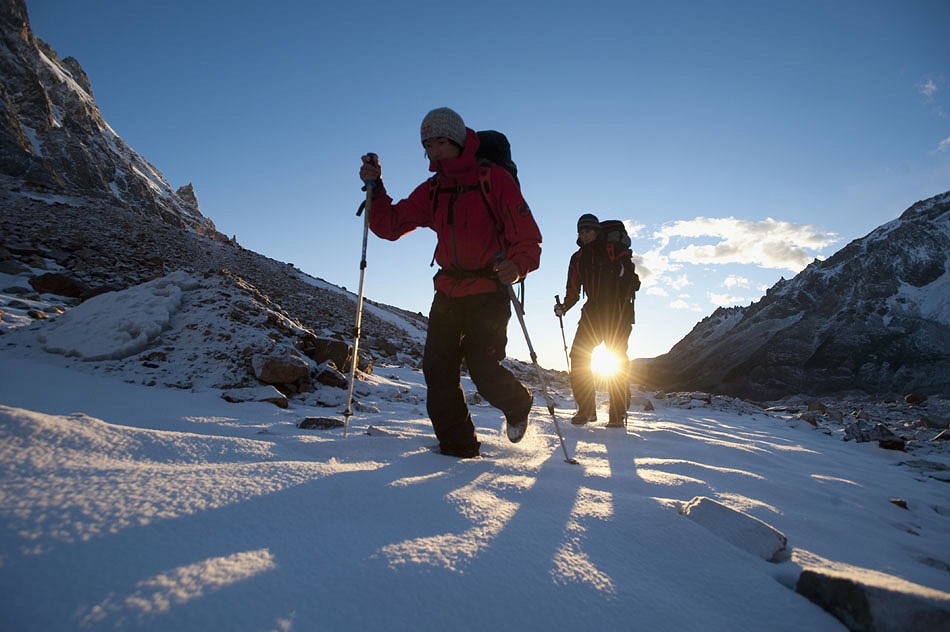
In 2010 you were part of a visiting Mammut Climbing Team who came to the Peak District to sample our gritstone. Did you enjoy the style of gritstone climbing?
I like the grit climbing a lot. I was actually there already before 2010 and also this September for a few days, together with a friend and we climbed some really nice routes.
There was another, smaller, controversy after the Mammut Team visit where many of the routes you climbing on the trip were left covered in chalk tick marks which is very much against the local ethic. Were you aware of this? Have you any thoughts about it now?
Regarding the Mammut team trip, there was a bunch of people trying the same routes and we also had a long spell of good weather without any rain. Retrospectively it was kind of peculiar that this topic seems to be attached to my name. Even though there is no ethic over in Austria that forbids ticking, I'm known to get mad if people don't brush away their chalk. I'm certainly aware of the local ethics, but I wasn't the only one climbing. I think that's all that needs to be said.
What are your future goals in your climbing?
I thrive most in trying things nobody has ever done before. Generally speaking, big, alpine faces with logical lines are what I'm looking for. Whereas there are hardly any left to find in the Alps, there are plenty in the Karakoram or in the Himalayas. That was the main reason why Peter and I also chose to attempt Chogolisa this year after climbing Trango Tower, which is kind of an unusual goal for climbers like us. We wanted to see what our body feels like way above 7000 meters, before we can go out next season and try to put up a new difficult climbing route in this altitude.
Good luck on your next trip - where are you headed? Or is it a secret? And can you tell us about Peter? And what you look for in a partner for these kind of adventures?
In 2013 I'm planning on heading back to Patagonia for my fourth consecutive year and in summer I'll be back in Pakistan. I'm not 100% sure yet where exactly I'll be heading, but I saw so many unclimbed walls I just have to go back.
Besides having what it takes to realize a project, my partner for big alpine projects needs to have a similar view on things as I do and has to be reliable. Peter is not only a strong alpinist, but also great guy and a good friend. Perhaps the only "downside" with having him as my main partner is that he simply cannot commit to expeditions as egoistically as I can. He has a family back home waiting for him.
Thanks David, have fun in Patagonia.
David Lama has several sponsors including Mammut and Red Bull



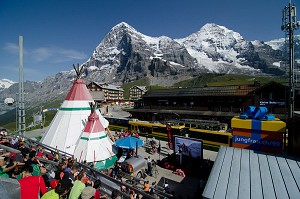
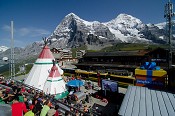
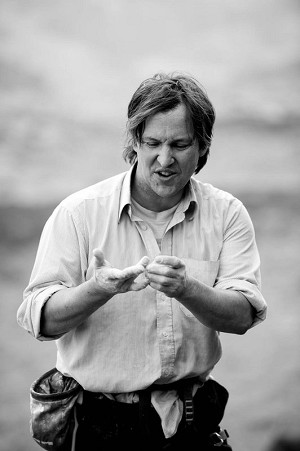
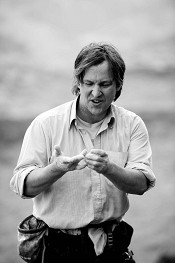








Comments